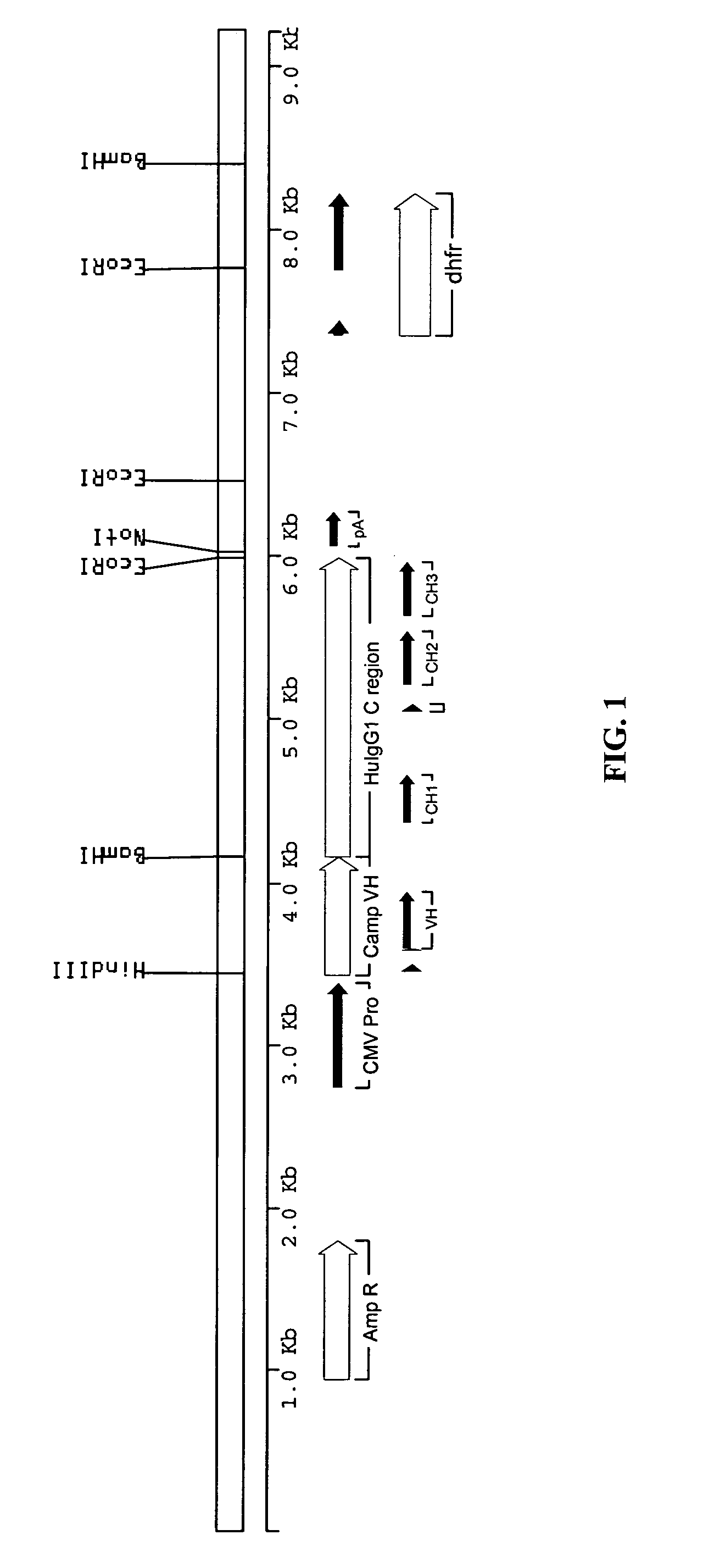Modified anti-CD52 antibody
a technology of anti-cd52 and modified anticd52, which is applied in the field of polypeptides, can solve the problems of inability to confirm the ability of a binding peptide to function as a t-cell, the inability to adapt techniques to screen multiple potential epitopes, and the inability to achieve multiple potential epitopes, so as to reduce the number of potential t-cell epitopes, reduce or eliminate the potential to induce an immune response, and increase circulation time
- Summary
- Abstract
- Description
- Claims
- Application Information
AI Technical Summary
Benefits of technology
Problems solved by technology
Method used
Image
Examples
example 1
Construction of Anti-CD52 Antibody VH and VK Genes
[0142]The sequence of the rat anti-CD52 antibody was derived from data base entries RNIGHCC1G for the variable domain heavy chain (VH), and RNIGKCC1G for the variable domain light chain (VK). The sequences were modified slightly to remove internal HindIII and BamHI sites without altering the amino acid sequence. The VH and VK genes were made by gene synthesis. Briefly, a panel of synthetic oligonucleotides was designed and synthesised. The genes were assembled using a ligase chain reaction (LCR) wherein the oligonucleotides featuring complementary ends were allowed to anneal followed by amplification and fill-in using a polymerase chain reaction (PCR). The PCR was driven by addition of an increased concentration of the flanking oligonucleotides to act as primers. The PCR products were assembled into full-length antibody genes by further PCR from vectors containing 5′ and 3′ immunoglobulin gene flanking regions and sub-cloning into ex...
example 2
Construction of Modified Antibody VH and VK Genes
[0149]Modified VH and VK genes were constructed by PCR mutagenesis using the rat anti-CD52 variable region cassettes generated in Example 1 as templates. Table 5 lists the oligonucleotides used in the production of modified VHs. The following mutations are identified by the Kabat number of the residue with the linear number relating to the respectively identified polypeptide acid sequence in parenthesis. DIVHv1 (polypeptide SEQ ID NO: 3; polynucleotide SEQ ID NO: 71) included the mutations K3Q (3), M18L (18), I37V (37), P40A (40), A41P (41), A44G (44), P45L (45), L48V (48), T74S (77), Q75K (78), M77T (80), T82bS (87), T89V (95), V107T (115), M108L (116), and used oligonucleotides VHVK5′CHO, DIVH1, DIVH2, DIVH3, DIVH4, DIVH5, DIVH6, DIVH7, DIVH8, DIVH9, DIVH10, and VH12. DIVHv2 (polypeptide SEQ ID NO: 4; polynucleotide SEQ ID NO: 72) included the mutations K3Q (3), M18L (18), A41P (41), L48I (48), T74S (77), Q75K (78), M77T (80), T82bS...
example 3
Expression, Purification and Quantitation of Anti-CD52 Antibodies
[0155]The host cell line for antibody expression was CHO dhFf, obtained from the European Collection of Animal Cell Cultures, Porton UK (ECACC No 94060607). The heavy and light chain expression vectors were co-transfected into CHO cells by electroporation. Colonies expressing the neo and dhfr genes were selected in Iscove's Modified Dulbecco's Medium (IMDM) without nucleosides, supplemented with 10% dialysed foetal bovine serum and 400 μg / ml geneticin (G-418 sulphate) (all from Gibco, Paisley, UK). Transfected cell clones were screened for production of human antibody by ELISA for human IgG [Tempest et al. (1991) BioTechnology 9: 266]. Cell lines secreting antibody were expanded and the highest producers selected and frozen down in liquid nitrogen. The anti-CD52 antibodies were purified using PROSEP®-A (Bioprocessing Ltd) antibody purification kits according to the manufacturer's instructions. The concentration was det...
PUM
| Property | Measurement | Unit |
|---|---|---|
| molecule weight | aaaaa | aaaaa |
| molecular weight | aaaaa | aaaaa |
| molecular weight | aaaaa | aaaaa |
Abstract
Description
Claims
Application Information
 Login to View More
Login to View More - R&D
- Intellectual Property
- Life Sciences
- Materials
- Tech Scout
- Unparalleled Data Quality
- Higher Quality Content
- 60% Fewer Hallucinations
Browse by: Latest US Patents, China's latest patents, Technical Efficacy Thesaurus, Application Domain, Technology Topic, Popular Technical Reports.
© 2025 PatSnap. All rights reserved.Legal|Privacy policy|Modern Slavery Act Transparency Statement|Sitemap|About US| Contact US: help@patsnap.com



